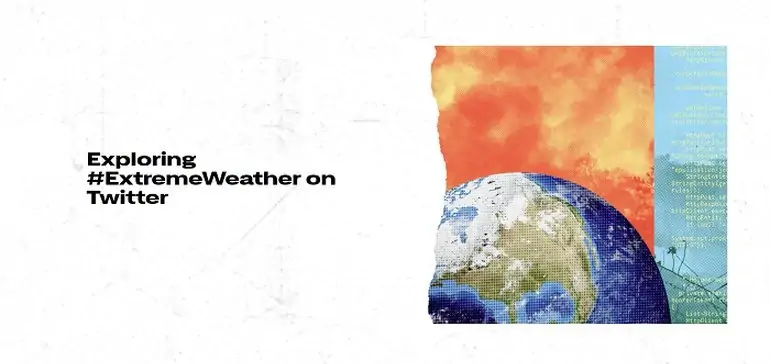Mobile App Development, SEO, Social Media, Uncategorized, Web Development, Website Design
Twitter Launches New #ExtremeWeather Mini-Site to Help Maximize Climate Change Messaging
- By Brett Belau
24 Sep

As we look to the post-pandemic future, discussion around climate change is rising once again, with the IPCC recently warning that the impact of human-caused climate disruption is already irreversible, and that average temperatures will rise by more than 1.5 degrees over the next two decades, if we don’t work collaboratively to address it.
The expanded impacts of those shifts will cause massive disruption – not quickly, you won’t suddenly by plunged into ice age like conditions, nor faced with inhabitable heat straight away, as some skeptics seem to suggest. But climate change is happening, and as such, it’s important that we do all we can to both communicate the science behind climate rises, and maximize cooperation between nations to tackle this shift.
Which is where Twitter’s looking with its new #ExtremeWeather visualization project.
As explained by Twitter:
“As extreme weather unfolds, people come to Twitter before, during, and after these events to talk about what’s happening. In fact, in a sample of English-language Tweets from 2013 to 2020, mentions of “climate change” grew an average of 50% over the 7 year period measured. This conversation has proven to be powerful and influential, as environmental activists use Twitter to raise awareness about the climate crisis, organize their communities, and connect with others passionate about protecting the planet.”
Leaning into this use case, Twitter’s new ‘Exploring #ExtremeWeather’ mini-site provides a range of climate case studies and data insight, based on tweet trends,
The mini-site includes a range of interactive visualizations, created in partnership Brandwatch, NTT Data, and Sprout Social, as well as overviews that enable visitors to explore tweet discussion trends around key events, including the Australian bushfires, the Jakarta floods and the Texas freeze.

As you can see in this example, the visualizations look at both how the broader conversation has evolved on Twitter, along with specific elements of interest and discussion, which could help to both provide more context into how trends grow, while also offering more scientific background as to the impacts of climate change.
“These #ExtremeWeather visualizations illustrate how climate change transcends all borders and highlight the importance of global collective action. We believe the developer community can play a key role in shaping how we prepare and respond to these #ExtremeWeather events by using our API in innovative ways, like building tools and dashboards that help people understand what’s happening.”
In addition to a general overview, Twitter has also included specific tweet insight for each trend, identifying key mentions that sparked increased discussion around each event.

Which is interesting when you also consider that Twitter has been identified as a key platform for climate change deniers and activists, who seek to use these same moments to bend the narrative in another direction, with bots, in particular, identified as a weapon of choice.
In the wake of the Australian bushfires, for example, researchers from Queensland University identified networks of Twitter bots that were using coordinated tweet pushes in order to play down the influence of climate change in the crisis, and instead amplify alternative, yet unfounded explanations relating to arson and government-imposed restrictions on controlled burns.
In 2019, Wired reported that bot profiles were still dominating political news streams, with bots contributing up to 60% of tweet activity around some events. And while Twitter is doing more to detect and remove bots, and address their impact in this respect, it is worth noting this additional element in Twitter’s broader push to showcase how its platform helps to connect people around crisis events.
Even so, this is an important initiative – and while it won’t become a mainstream, broad messaging tool to underline the impacts of climate change, it will help researchers develop more understanding of how to use tweet trends to explore key elements, particularly in relation to maximizing climate messaging, and encouraging action.
You can check out Twitter’s #ExtremeWeather mini-site here.
Source: www.socialmediatoday.com, originally published on 2021-09-23 19:57:27
Connect with B2 Web Studios
Get B2 news, tips and the latest trends on web, mobile and digital marketing
- Appleton/Green Bay (HQ): (920) 358-0305
- Las Vegas, NV (Satellite): (702) 659-7809
- Email Us: [email protected]

© Copyright 2002 – 2022 B2 Web Studios, a division of B2 Computing LLC. All rights reserved. All logos trademarks of their respective owners. Privacy Policy

![How to Successfully Use Social Media: A Small Business Guide for Beginners [Infographic]](https://b2webstudios.com/storage/2023/02/How-to-Successfully-Use-Social-Media-A-Small-Business-Guide-85x70.jpg)



![How to Successfully Use Social Media: A Small Business Guide for Beginners [Infographic]](https://b2webstudios.com/storage/2023/02/How-to-Successfully-Use-Social-Media-A-Small-Business-Guide-300x169.jpg)


Recent Comments